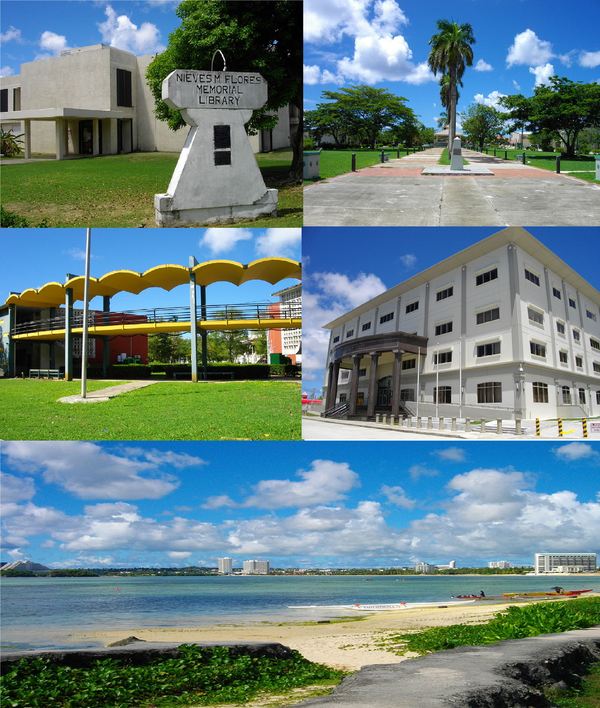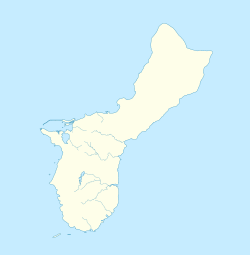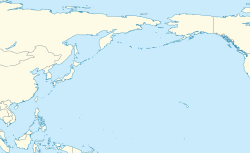Top Qs
Timeline
Chat
Perspective
Hagåtña, Guam
Capital city of Guam From Wikipedia, the free encyclopedia
Remove ads
Hagåtña,[a] formerly Agana or Agaña,[b] is a coastal village and the capital[3] of the United States territory of Guam. From the 18th through mid-20th century, it was Guam's population center, but today, it is the second smallest of the island's 19 villages in both area and population. However, it remains one of the island's major commercial districts in addition to being the seat of government.
Remove ads
Etymology
"Hagåt" (also romanized as haga', with a glottal stop instead of a syllable-final "t") means "blood" in the Chamorro language. The suffix "-ña" can be translated as either the possessive pronouns his, hers or its in English (cognate to -nya in Malay and Indonesian, and niya in Tagalog), or a signification of greater comparative degree, similar to some uses of the English suffix "-er". There is much speculation that the indigenous peoples originally migrated from the village of Agat/Hagåt. Therefore, "Hagåtña" can be translated "his or her blood" possibly meaning "related to him, her or it", or it could be translated to what might roughly mean "more Hagåt", as in, an extension of the village of Hagåt. It could also mean "better Hagåt", or "more than, surpassing or superior to Hagåt" in a sense of being "more Hagåt than Hagåt itself". In 1998, the Guam Legislature changed the name from "Agana" back to the original Chamorro form. However, the name of the neighboring village Agana Heights remains unchanged.
Remove ads
Geography
Summarize
Perspective
Hagåtña is located at the mouth of the Hagåtña River on Guam's west coast. According to the United States Census Bureau, the city has a total area of 1 square mile (2.6 km²). It is (by direction of travel) the westernmost state or territorial capital city of the United States. The village is bounded by the sandy beaches of Agana Bay to the north, the Hagåtña River and associated wetlands to the east, and a cliff (above which is the village of Agana Heights) to the South. Several high-rise office buildings are in the center of the village, while the western portion of the city known as Anigua is more residential. Unlike many villages, central Hagåtña is divided into city blocks with shops and small restaurants throughout the center of the village. Highly populated residential areas in the villages of Mongmong-Toto-Maite, Sinajana, and Agana Heights surround Hagåtña.
Climate
The city has a tropical rainforest climate (Köppen: Af) similar to that found in the Amazon Basin.[4] Rainfall is high especially from June to November, reaching 978 millimeters (38.50 in) in a single month in August 1997, whilst the year 2004 was the wettest in history with 3,539 millimeters (139.33 in).[5]
Remove ads
History
Summarize
Perspective
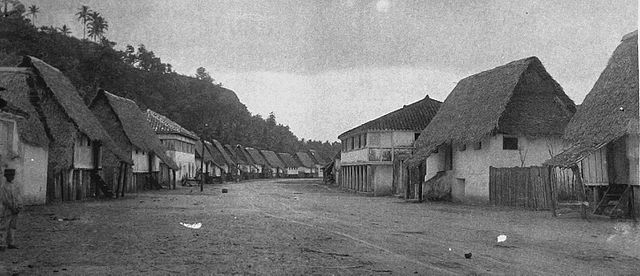

Hagåtña was a prominent village before Guam's colonization by the Spanish. In 1668, the first Spanish missionary led by the Spanish priest San Vitores and his team arrived on the island. The colonizers proselytized and forced the indigenous Chamorro people to convert to Christianity, in many cases without consent.[7][8] One of those who converted, Chief Kepuha, donated land in Hagåtña enabling San Vitores to build the first church (Dulce Nombre de Maria Cathedral-Basilica) on Guam, which was used by San Vitores to further colonize the indigenous peoples and their lands.[9][10]
Under Spanish rule, and particularly the Spanish-Chamorro Wars, much of the indigenous population of Guam and other Mariana Islands were forced to relocate to the city after a genocide was instigated and conducted by the Spanish, led by San Vitores, against the indigenous population.[11][12] The remains of buildings from the Spanish administration can be seen in the Plaza de España located beside the cathedral of the Archdiocese of Agaña. The remains of the Spanish Governor's Palace is here and is closer to the Department of Education than the Cathedral.
After Guam was ceded by Spain to the United States in the Spanish–American War of 1898, Hagåtña remained the seat of government under U.S. Naval Administration. By 1940, the city's population had grown to about 10,000 containing nearly half of the island's residents. Villages had been established nearby for immigrants from the Caroline Islands.
Guam was captured by Japanese forces on December 8, 1941. The Japanese renamed Guam to Ōmiya-jima (Japanese: 大宮島), or Great Shrine Island, and Hagåtña to Akashi (Japanese: 明石), or Bright Stone. During Guam's 1944 liberation from the Japanese during World War II, the city was heavily damaged by U.S. naval bombardment. Many former residents settled in other parts of Guam after the war. As part of Guam's reconstruction plan, the U.S. Navy constructed new, straight city streets that passed through existing lots and created many plots of land with multiple owners. This has hindered the development of the city to the present day. In December 1944, Guam was the scene of the Agana race riot, between black and white servicemen stationed on the island.
Today, despite a resident population of about 1,000 (less than 1% of Guam's total), the city remains the seat of the territorial government. Its historic sites are major attractions for visitors. Hagåtña is served by Antonio B. Won Pat International Airport in Tamuning and Barrigada.
Remove ads
Culture
As Guam's historic population and administrative center, many traditional celebrations take place in Hagåtña. On December 8, Santa Marian Kamalen, Patroness of the Mariana Islands, is honored with a procession in which a statue of the patroness is pulled on a cart amid the prayers of thousands of the island's Catholics.[13] Guam's most celebrated patriotic holiday, Liberation Day, is on July 21. The annual Liberation Day Parade takes place on Marine Corps Drive in Hagåtña. In addition to the historic sites at the Plaza de España and the Basilica, Latte Stone Park and the Chamorro Village shopping area offer further information about the island's history and culture.
Remove ads
Demographics

The U.S. Census Bureau has the municipality a single census-designated place.[14]
Infrastructure and government
The island's capital, the legislature, the governor's office and other government offices are in Hagåtña. The Government House (Chamorro: Guma I Taotao Guam), traditionally the governor's official residence, is situated above the cliff but technically within the city limit of Hagåtña. Adelup Point is the home of the Ricardo J. Bordallo Governor's Complex.
The Guam Department of Corrections operates the Hagåtña Detention Facility in Hagåtña.[15]
Notable federal government agencies in Hagåtña include the District Court of Guam at 520 West Soledad Avenue,[16] the United States Attorney at Sirena Plaza, 108 Hernan Cortez, Suite 500,[17] and the United States Postal Service Post Office at 223 West Chalan Santo Papa.[18]
Remove ads
Twin towns and sister cities
Hagåtña is twinned with:
 Guadalajara, Jalisco, Mexico[19]
Guadalajara, Jalisco, Mexico[19] Quezon City, Philippines, since October 2000[20]
Quezon City, Philippines, since October 2000[20] Malolos, Bulacan, Philippines[21]
Malolos, Bulacan, Philippines[21] Legazpi, Albay, Philippines
Legazpi, Albay, Philippines
Education

Primary and secondary schools
Public schools
The Guam Department of Education serves the entire island of Guam.
Hagåtña residents are zoned to:
- Carlos L. Taitano Elementary School (Sinajana)
- Jose L. G. Rios Middle School (Piti)
- John F. Kennedy High School (Tamuning)[22]
In regards to the Department of Defense Education Activity (DoDEA), Hagatna is divided between two school transportation zones. People living north of Guam Highway 4 are zoned to Andersen Elementary and Andersen Middle School, while people living south of Guam Highway 4 are zoned to McCool Elementary and McCool Middle School. Guam High School is the island's sole DoDEA high school.[23]
Private schools
Private schools in Hagåtña include:
- Academy of Our Lady of Guam (Catholic girls' high school in Hagåtña)
- Harvest Christian Academy (Christian school in Mong Mong Toto Maite)
Public libraries
The Guam Public Library System operates the Nieves M. Flores Memorial Library at 254 Martyr Street in Hagåtña.[24]
Remove ads
Sites of interest


- Gregorio D. Perez Marina (formerly, Agana Boat Basin)
- Agana Shopping Center
- Chamorro Village
- Chief Quipuha Park
- Dulce Nombre de Maria Cathedral Basilica
- Fort Santa Agueda
- Guam Congress Building
- Guam Museum
- Latte Stone Park
- Paseo Stadium
- Plaza de España
- Ricardo J. Bordallo Governor's Complex
- San Antonio Bridge (Tollai Achote)
- Sirena Park
Notable people
- Ben Ada, politician
- Sian Proctor, commercial astronaut
- Jason Cunliffe, Guam international footballer
- Ann Curry, journalist born in Agaña
- Venancio Roberto, two-day Governor of Guam.[25]
- Kimberley Santos, Miss World 1980 (succeeded)
- Frank Camacho, mixed martial artist
- Vicente T. Blaz, Brigadier General in the U.S. Marine Corps and former Guam delegate to the U.S. House of Representatives, born in Hagåtña
Remove ads
Government
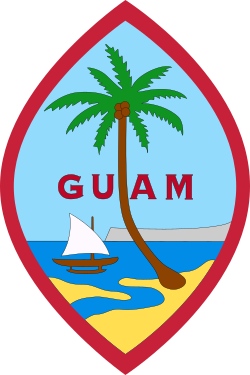
Remove ads
Notes
- /həˈɡɑːtnjə/ hə-GAHT-nyə,[2] Chamorro pronunciation: [hæˈɡɑtɲæ] ⓘ.
- /əˈɡɑːnjə/ ə-GAH-nyə, Spanish pronunciation: [aˈɣaɲa] ⓘ.
References
External links
Wikiwand - on
Seamless Wikipedia browsing. On steroids.
Remove ads
